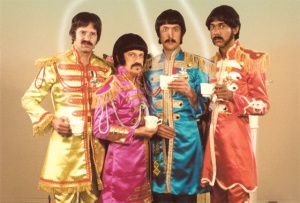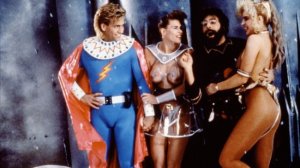Rating: 5/5
“This is the way the world ends. This is the way the world ends. Not with a whimper, but with a bang.”
Having attained cult status and acclaim for his feature debut Donnie Darko, writer-director Richard Kelly’s second film was eagerly anticipated by many – until it premièred at Cannes in 2006. Having already been significantly delayed, it received arguably the worst reception at the festival: audiences were not even interested in booing it, preferring to simply walk out. The film ended up with the lowest ratings of the festival, a meagre 1.1/5, and Kelly returned to the editing suite in a last-ditch attempt to salvage what was widely acknowledged as an incoherent mess. The work is visible in the film, which was eventually released at the end of 2007 – extensive voice-over, a mass of information at the beginning overloading the brain with facts and throwing the audience straight into the action, strange animated shots taken from the prequel comic books (another attempt to provide some coherence to the plot), new special effects. Characters who once possibly featured prominently now pop up for brief scenes – an unrecognisable Kevin Smith, for example, or a blink-and-you’ll-miss-it cameo from Janeane Garofalo in one of the final shots. It still barely makes sense – I’ve seen it dozens of times by now, and every time I realise something new, notice something crucial that I’d completely missed, lose track of the plot. It emerges like a fevered dream, hypnotic and surreal, a bizarre mixture of pop culture and theology, a supremely convoluted plot with a vast cast of eccentrics and weirdos spouting nonsense. It’s a marmite movie: you’ll either love it or hate it. I love it.
To recount the plot would, quite simply, take too long, but it goes something like this. It’s 2008, the future, and the government has become a paranoid Big Brother. Travel is restricted between states, but an actor with amnesia called Boxer Santaros (Dwayne Johnson, billed as his real name for the first time) has somehow ended up writing a screenplay with a psychic porn star (Sarah Michelle Gellar) that foretells the end of the world. Meanwhile Sean Patrick Scott is identical twin brothers, one impersonating the other, while the Neo-Marxists, a rebel organisation, collect fingers in an attempt to bring down Usident, the government surveillance operation led by Nana Mae Frost (Miranda Richardson), wife of senator Bobby Frost (Holmes Osbourne). Pilot Abilene (Justin Timberlake), a war veteran turned drug addict also monitors from his platform above Venice Beach, looking over the newly built Fluid Karma factory, a new technology developed by Baron Von Westphalen (Wallace Shawn) that could spell the end of global fuel shortages. And so it goes on. In this confused, and confusing, tangled web of a narrative, characters come and go, scandals are revealed, and the apocalypse begins. No pressure or anything.
It could either be a criticism or praise (I mean it as the latter) that Kelly’s screenplay throws the audience right into the middle of the story. The film is divided into three chapters, which are parts four, five, and six, each one named after a song (Temptation Waits by Garbage, Memory Gospel by Moby, and Wave of Mutilation by The Pixies). The first three chapters have subsequently been released in comic book form, but they, like the Donnie Darko director’s cut, are a complete disappointment, revealing that, in reality, Kelly never intended his story to be incoherent. The comics are far more linear – still bizarre – and much of the film’s impact is lost as a result. A brilliantly bonkers scene in the middle of the film, when a large number of the cast meet and all accuse each other of betrayal, is made redundant if one has read the comics, for example. The beauty of the film is that, like Donnie Darko, the audience is expected to fill in the blanks, to reach its own conclusions – the comic books take away that authority, reducing the film’s power to something far more mundane.
There’s so much to praise about Southland Tales. The cast, largely comprised of character actors and those who had previously been typecast in specific roles, all ham up their roles to perfection. Gellar is great as Krysta Now, the porn star with lofty intentions. Timberlake excels, and features in one of the film’s finest scenes, a surreal drug trip that comes out of nowhere. Dwayne “The Rock” Johnson took a chance here, but it remains my favourite role of his – he’s charismatic, ironic, twitchy, funny and sympathetic – none of his other roles to date have offered him the chance to expand his repertoire as much as this one.
Kelly’s style is evident as well. There are moments that are reminiscent of Donnie Darko: the importance of music (he has been criticised for basically delivering a series of music videos); the slow motion dance sequences that become unsettling and strangely sinister; the apocalyptic narrative with, at its core, one man’s opportunity for salvation; that stunning tracking shot in the mega zeppelin near the film’s end, as the camera follows Bai Ling through the crowd. Southland Tales is an assault on the senses, each scene filled with beauty and chaos and new things to look for. It’s hectic and manic, seemingly spewing forth without direction, but it all ties together just enough. With references to Revelations, Robert Frost, TS Eliot and others, the characters diverge together, each one responsible for bringing the end of days a little closer, yet all the philosophy is ultimately reduced to one simple question: are you a pimp or not? It’s this kind of audacious combination of high concept and low culture that emphasises the film’s tongue-in-cheek stance – it’s not meant to be taken entirely seriously, but there’s plenty to think about regardless.
I have always maintained that, given enough time, Southland Tales will be reclaimed as a masterpiece. That has yet to happen, but time has been favourable for the most part. In its year of release, it was – like Only God Forgives last year – found on both the “best films” and the “worst films” lists. Its almost perfectly average rating on IMDb (5.5/10) is the result of extreme opinions – everyone either gives it one or ten. For me, this is precisely the kind of film that is interesting: not the average and mundane, but the divisive, the controversial. For better or worse, Southland Tales is the latter – a film that has so much to say it perhaps forgets to say any of it properly, a film that is messy and muddled, stylish and superficial yet complex. For me, it’s one of the finest films of the last ten years. I welcome the counter-arguments!









